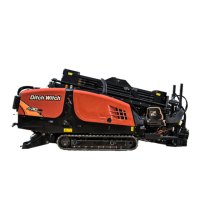
Do you have a question about the Ditch Witch JT30 and is the answer not in the manual?
| Brand | Ditch Witch |
|---|---|
| Model | JT30 |
| Category | Utility Vehicle |
| Language | English |
Location of serial numbers for identification and record-keeping.
Describes the purpose and design of the JT30/JT30 All Terrain drilling unit.
Identifies and labels the major parts of the drilling unit.
Essential safety rules to follow before operating any jobsite equipment.
Explains the meaning of danger, warning, caution, notice, and important terms.
Outlines critical actions for electric strikes, gas leaks, fires, and other emergencies.
Details the switches and controls on the main setup console.
Explains the functions of the remote drive controller for steering and speed.
Describes indicators, engine display, and pipeloading/drilling controls.
Details joysticks, switches, indicators, and gauges on the right console.
Explains the various displays and indicators on the information center screen.
Steps for gathering information, planning the job, and preparing the jobsite.
Procedures for conducting the drilling and backreaming operations.
Steps to gather data, inspect the site, and classify hazards.
Guidance on planning the route and parameters for the drilling path.
Steps for starting the unit and operating the steering controls.
Steps for safely stopping and shutting down the drilling unit.
Procedures for safely loading, tying down, and securing the unit for transport.
Procedures for safely unloading and towing the drilling unit.
Steps for connecting the drill pipe, bit, and other components.
Procedures for drilling the first pipe, adding pipe, and controlling direction.
Steps for enlarging the drilled hole and removing the drill string.
Procedures for setting up and using the anchor system for stability.
Information on setting up, testing, and using the electric strike detection system.
Details on drilling fluid types, mixing, and requirements for optimal performance.
How to use the tracker system to control drilling unit functions remotely.
Procedures for loading, unloading, and managing drill pipe with the pipeloader.
How to engage, adjust, and use the cruise control for steady operation.
Lists error codes and their meanings for engine and machine systems.
Explains limitations and effects on automated functions when in Service Mode.
Steps for adding antifreeze to protect the unit from freezing.
Instructions for cleaning the unit using a washwand after operation.
Procedures for disconnecting hoses and stowing tools securely.
General safety guidelines and warnings for performing maintenance and service.
Lists approved oils, greases, fluids, and their specifications.
Maintenance tasks to perform during the initial 10-hour service check.
Maintenance tasks required every 50 hours of operation.
Maintenance tasks required every 250 hours of operation.
Maintenance tasks required every 500 hours of operation.
Maintenance tasks required every 1000 hours of operation.
Maintenance tasks required every 2000 hours of operation.
Maintenance and checks to be performed as needed based on conditions.
Provides physical dimensions and operating mass of the unit.
Details specifications for power, all terrain, and cobble pipe types.
Lists performance metrics like speed, torque, and forces.
Details for Tier 3 and Tier 4i engines, including displacement and power.
Information on onboard fluid systems and tank capacities.
Information on obtaining manuals, videos, and training from the dealer.
Outlines the terms, conditions, and exclusions of the product warranty.
Lists items and conditions not covered by the product warranty.